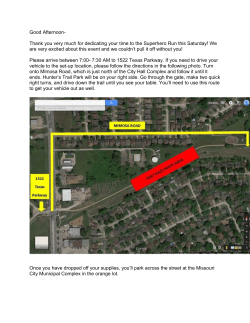
Heavy vehicle dynamics optimization - LaMCoS
Heavy vehicle dynamics optimization , Yerlan Akhmetov1,3, Didier Rémond1, Lionel Maiffredy1, Wilfrid Marquis-Favre2 2 3 Michael Di Loreto , Virginie Harth 1LaMCoS, INSA-Lyon 2Ampère, INSA-Lyon 3Volvo 3P Background Heavy vehicles are mainly exposed to two principal risks on the road: rollover and lateral instability. Conventional ESP permits to solve partially the problem by using the differential braking, but despite all benefits of the system the vehicle performances can still be improved. This improvement can be achieved by combining the braking action to the actions of other available actuators installed on the vehicle such as steering system and active/semi-active suspensions. There are many different ways to integrate the actuators into global chassis control such as supervisory, decentralized, centralized control techniques. In our study we adopt a promising centralized control, by consequence a high vehicle’s over-actuation problem has to be solved. The over-actuation of the heavy vehicle is handled by using the control allocation technique which is already applied in the domains of aeronautics, marine vessels, robotics and studied for road vehicles. The study includes the vehicle dynamics and actuators modeling and controller design. Vehicle dynamics modeling Actuators modeling Braking system Gcr Gcab Solo vehicle P6x2Tag: Pcommand Gcf Flexible frame Suspended cab Trailing arms suspensions modeling Pacejka tire model Gur Driver interpreter Motion controller Pe Guf δcommand plant v u Control allocator uact Actuators Vehicle dynamics y x x& = f ( x) + g ( x)u y = h( x ) 1 τs + 1 δ Control requirements constraints Vehicle dynamics: K Ps Pbrake Rear Active Steering controller r 1 τs + 1 Gum Modular control design driver‘s actions Rapprochement pressure or x& = f ( x) + v Vehicle rollover prevention Vehicle yaw control Optimal use of the tire potential Handle actuators redundancy and constraints Fz Fy Fx tire forces generation potential Control allocation y = h( x ) Solves constrained underdetermined (m > n) problem: Driver interpreter (linear one-track model): translates drivers n actions into desired vehicle’s trajectory r ∈ R Motion controller: defines total control effort v ∈ R applied to the vehicle n to be Control allocator: maps total control effort vector v into m actuators inputs u ∈ R g ( x)u = v Linear case is considered: Bu = v u is constrained in position and in rate u≤u≤u Possible solution: real-time constrained convex optimization ( u = arg min Wu (u − udes ) p + γ Wv ( Bu − v) For over-actuated systems m > n p ) Exemple: Yaw control Vehicle’s yaw rate Controlled vehicle: actuator inputs Maneuver definition Initial speed: 40 km/h Steering input: Sine with dwell Rear active steering Braking torques Brake/gas pedals: No action Adherence: 50% Steering input Rear axle Middle axle Front axle yerlan.akhmetov@insa-lyon.fr LaMCoS, Université de Lyon, CNRS, INSA-Lyon UMR5259, 18-20 rue des Sciences - F69621 Villeurbanne Cedex
© Copyright 2025











